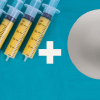Breast augmentation is one of the most commonly performed cosmetic procedures. The total number of implants worldwide is estimated to be between 5-10 million.
Breast implant technology has continued to improve with today’s implants having a wide variety of sizes and shapes available and low rates of capsular contracture (or hardening) of the implant. Implant surfaces can be smooth or textured, coming in anatomical (teardrop) or round shapes and can be filled with either silicon or saline. Newer technology are polyurethane-coated silicon implants (often called “furry” due to the feel of the coating) which has the lowest rate of capsular contracture and a minimal risk of rotation and movement due to this special coating.
- Size is the most important factor in choosing a breast implant.
The absolute volume of a breast implant whilst important is not the most critical factor in deciding which implant will look best on a particular individual. The biggest factor in achieving a successful, natural looking breast augmentation is selecting the correct shape for a particular person’s body type. This is determined by the base width (which is related to the width of the chest), the height of the implant and the projection. Two implants with the same absolute volume can have very different shapes and the exact same implant can look vastly different on two different bodies. Differences in skin quality, how much fat or breast tissue an individual has and nipple position will influence implant selection. Sizing in the office with a sports bra is a good way to simulate how a particular implant will look.
2) Breast implants cause autoimmune disease.
There have been large multicenter scientific studies with hundreds of thousands of women with breast implants following scares in the 1990s of an association between autoimmune disease and breast implants. These studies have never shown any link between autoimmune disease and breast implants. Silicone gel breast implants are actually the most widely studied medical device in the history of medical devices.
3) Breast implants cause cancer.
There is no increased risk of breast cancer with breast implants.
Recently, a rare type of lymphoma called Breast Implant-Associated Anaplastic Large Cell Lymphoma (BIA-ALCL) has been identified in association with implants. It is statistically extremely rare with currently over 200 cases worldwide.
BIA-ALCL has been reported across all implant brands. It usually presents as a late seroma (fluid collection) or a breast mass. It requires surgical removal of the implant and surrounding capsule. Thankfully most cases have had a good prognosis. Due to its rare nature, data is still emerging regarding its true incidence and the exact causes. Heavily textured implants have been implicated more commonly than smooth implants, suggesting a site- and material-specific chronic inflammatory cause.
4) I cannot breastfeed with implants.
Scientific studies have demonstrated there is no risk for babies breastfed by women with breast augmentation with implants. Pregnancy is likely to affect the appearance of breast implants due to changes in the the size and shape of the breasts during pregnancy. There is a small risk that breast implant surgery can reduce nipple sensation and breastfeeding may be affected. It is also important to note that some women may never be able to breastfeed regardless of whether they have breast implants or not.
5) I will need to replace my breast implants every 10 years.
Breast implants, like any device, cannot be expected to last forever. However, when they will need to be replaced can vary and there is no absolute necessity to replace them at 10 or even 15 years if there are no complications and their appearance is good.
With current cohesive gel implants ruptures are rare as is capsular contracture, both the most common reasons for replacement. In the absence of problems, the most common reason for revision breast augmentation is deterioration in cosmetic result. Due to changes in body shape, childbirth and breastfeeding, implants may not end up looking as good as when they were originally placed. Revision surgery may require a change in size or shape to achieve optimum results.
Capsular contracture refers to hardening of the implant due to excessive scar formation around the implant which contracts (becomes smaller around the implant) and can lead to distortion and pain in the breast implant. Although rates are low, it can still occur and can be in one or both breasts at any time following surgery. Polyurethane-implants currently have statistically the lowest risk of capsular contracture and are the only implant to carry a 10 year warranty for capsular contracture and rotation.
Having breast implants with Dr Simone Matousek






